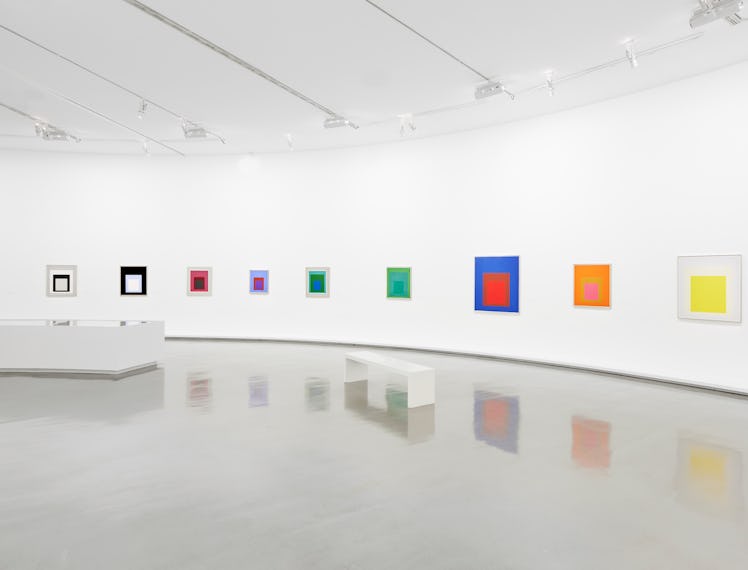It wasn’t his art history degree from Columbia University that would lead Nicholas Fox Weber, now the Executive Director of the Albers Foundation, into the art world. It was romance. Or, more accurately, an attempt at one. “I fell in love with a girl who, to my disappointment, was not in love with me,” Weber tells W. “But she still took me to meet her parents, who collected work by Josef and Anni Albers, the pioneering modernist couple known for their uniquely intertwined approaches to color and geometry. Upon seeing it, I was absolutely awestruck.”
At the time, Weber was in his early 20s and, conveniently, a mother of one of his friends was acquainted with the Alberses. They would meet in person a few years later. “I thought I was dressed rather neatly,” Weber says, noting his beige corduroy pants. But, the car grease that got on his clothes from trying to fix his engine moments before would be the first thing Josef noticed. “He didn’t even say hello. He looked at me up and down and said ‘What do you do, boy?’”
Josef and Anni Albers first met at the Bauhaus, and became early purveyors and innovators of twentieth-century modernism. Josef typically worked with glass and wood, while Anni boasted her skills with textiles and printmaking. Paintings from Josef’s iconic “Homage to the Square” series hang in The Guggenheim Museum, The Metropolitan Museum of Art, MoMA, and the Whitney Museum of American Art (during the Obama administration, one hung in the White House). Even Hermès has paid homage to the late artist, taking his signature square works and printing them on silk scarves.
The day they met Weber in 1971, Anni served a decidedly casual lunch. “They put the Kentucky Fried Chicken onto a perfect white Bauhaus serving tray with impeccable white Bauhaus porcelain. I thought, My god, they can make Kentucky Fried Chicken look like a dream. Absolutely beautiful and elegant.” At the time, the Alberses were well into old age and Weber would only get to spend five “intense” years with both of them before Josef passed away at the age of 88. Anni joined him 18 years later.
Nearly half a century after that first meeting, Weber is celebrating the artistic couple—and the 5oth anniversary of the foundation—with a retrospective at the Musée d’Art Moderne de Paris. As someone who shared a close relationship with the two, Weber says, “It is an honor to create an exhibition that continues to bring life and light into their legacy.”
The duo’s expansive collection of work is on full display, taking up more than half of the museum’s Bauhaus wing. Art enthusiasts from all over are offered the opportunity to fully immerse themselves in the vibrant and innovative pieces that are arguably the source of inspiration for many artists and designers working today.
Anni’s geometrical and colorful textiles from the 1920s, found in the first wing, showcase her technical expertise. Some are placed strategically adjacent to the Bauhaus-style chairs the pair created. For those interested in jewelry, handmade elaborate necklaces made up of eclectic materials are encased in glass. Her monumental “Six Prayers,” made in honor of her Jewish heritage, is displayed, to be observed from a bench the two designed.
Josef’s infatuation with the square is sprinkled throughout each wing: a blue and green piece here, an orange and red one there. The exhibition also charts how he transitioned his love for squares from canvas and prints to table sets. Nearby sits his glass fruit bowl with open sides. (When Weber marveled over it to Josef for the first time, Anni responded with, “Don’t be silly. Think about what would happen if a blueberry was put in there.”)
Not only does the exhibition speak to their work as individuals, it also explores their artistic partnership and dynamic. While there are certainly distinctions between the mediums they chose, it’s easy to notice how one another influenced each other, whether it be by color, pattern, or shapes.
Perhaps, the exhibition speaks on their relationship, too. “There was such an interplay between them,” says Weber. According to him, the two reflected a two-person set. “They were similar in physical appearance white, gray hair, rather pale, and almost the same height. But they knew who they were, what they wanted, and what they believed in.”
The exhibition concludes with ten drawings by Anni. These works appear more sporadic in design and lack the precision that her earlier works consisted of. “Anni’s hands became so shaky because of her age. Instead of fighting it, she embraced it,” explains Weber. “She let her shaky hand guide her and saw it as a source of inspiration. She experimented with colors. She did something new, and always moved forward, just as the Alberses did throughout their lives.”
The exhibition Anni et Josef Albers: L’art et la vie is on view at the Musée d'Art Moderne de Paris until January 9th, 2022.
This article was originally published on
